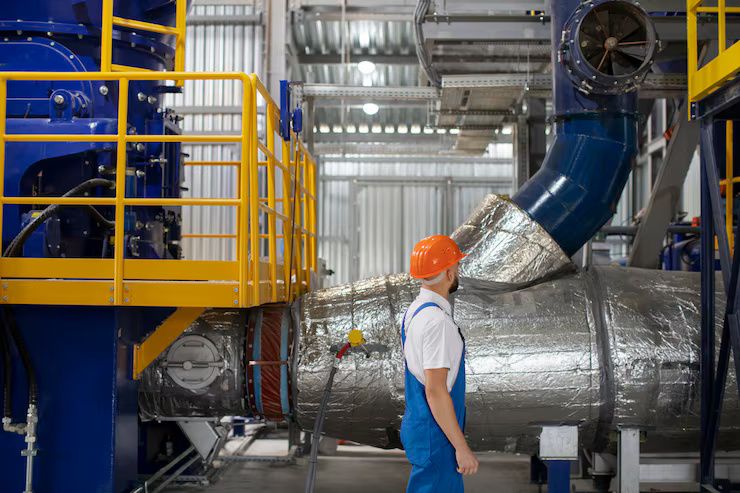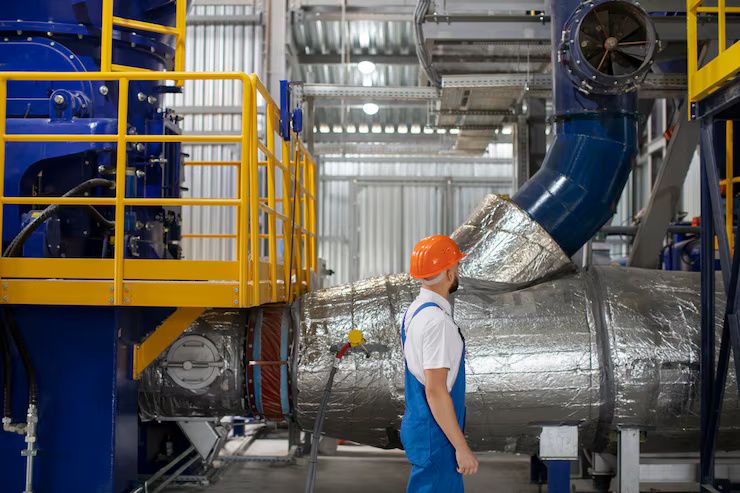Industrial blowers are mechanical devices used to move air or gas in a controlled manner. They are essential for ventilation, cooling, material handling, drying, combustion, and air pollution control in various industrial settings. These systems are typically larger and more powerful than domestic fans, built to handle continuous operations in demanding environments.
There are different types of industrial blowers, such as centrifugal blowers, axial blowers, and positive displacement blowers. Each type is selected based on pressure requirements, air volume, and application area.
Industrial blowers are found in factories, wastewater treatment plants, power stations, food processing units, chemical plants, HVAC systems, and more. Their main purpose is to ensure air movement that supports production, safety, or environmental control.

Why industrial blowers matter in today’s world
In modern industrial operations, managing airflow is critical for safety, efficiency, and regulatory compliance. Industrial blowers address several practical needs and challenges:
Who uses them?
-
Manufacturers
-
Utility providers
-
Construction firms
-
Mining operations
-
Agricultural processors
Key problems they help solve:
-
Remove dust, fumes, or toxic gases from workspaces
-
Regulate temperature in machinery and systems
-
Improve air quality in confined or hazardous environments
-
Facilitate combustion in kilns, furnaces, or boilers
-
Dry materials during production processes
Why it matters now more than ever:
-
Occupational safety: Controlling airborne pollutants reduces health risks.
-
Energy efficiency: Well-designed blower systems save energy and operating costs.
-
Environmental impact: Proper ventilation helps meet emission control standards.
-
Process optimization: Stable airflow is essential for consistent industrial outputs.
Industries are under growing pressure to reduce emissions, save energy, and improve worker safety—all areas where industrial blowers play a significant role.
Recent updates and trends in industrial blower technology (2024–2025)
The past year has seen notable innovations in industrial blower systems:
| Trend | Description |
|---|---|
| Energy-efficient motors | Brushless DC motors and variable frequency drives (VFDs) are increasingly used to optimize energy consumption. |
| Smart monitoring | IoT-enabled blowers now provide real-time performance data, predictive maintenance alerts, and automated controls. |
| Noise reduction improvements | New blade designs and acoustic enclosures help reduce operational noise, especially in urban or indoor settings. |
| Use of composite materials | Lighter and corrosion-resistant materials are being adopted to improve blower lifespan and reduce maintenance needs. |
| Demand for custom solutions | Industries are moving toward tailor-made blower configurations that meet specific airflow, pressure, and space constraints. |
In March 2025, several manufacturers introduced blower systems integrated with AI-based diagnostics, allowing for early detection of mechanical issues. Also, regulations encouraging low-emission industrial operations have increased the adoption of high-efficiency blower systems globally.
Laws and regulatory frameworks affecting industrial blowers
Industrial blowers are often subject to national and international safety, environmental, and energy-efficiency regulations. Here are key policy areas where they are commonly regulated:
| Regulation | Region | Focus |
|---|---|---|
| OSHA ventilation standards | USA | Ensures worker safety by mandating proper ventilation in workplaces. |
| Clean Air Act | USA | Blowers used in emission control systems must meet performance standards. |
| EU Ecodesign Directive | Europe | Requires energy-efficient motor systems for industrial blowers. |
| IS 4894 | India | Specifies performance and safety standards for industrial centrifugal blowers. |
| ISO 5801 | Global | Outlines methods for testing airflow and energy performance of blowers. |
Compliance with these standards not only ensures safety and environmental responsibility but also avoids potential legal and financial penalties. Many industries are required to document airflow rates, noise levels, and energy usage to meet regulatory benchmarks.
Tools and resources for managing and selecting industrial blowers
Choosing and operating the right blower requires careful planning, performance analysis, and routine maintenance. Here are some useful tools and platforms:
Selection Calculators & Sizing Tools:
-
FanCalc by Twin City Fan – For performance curve analysis
-
Greenheck Fan Tools – Includes blower selection calculators and 3D model access
-
HVAC Solution Software – For complete system design with integrated blowers
Standards and Guidelines:
-
AMCA (Air Movement and Control Association) – Provides detailed certification, testing, and sizing guidelines
-
ASHRAE Standards – Guidelines for air quality and ventilation in HVAC design
Maintenance & Monitoring Apps:
-
SKF Pulse – Monitors vibration and temperature of rotating machinery
-
Fluke Connect – Tracks motor conditions and predicts issues
-
ABB Ability Smart Sensor – Offers condition-based maintenance insights for motors and drives
Educational Resources:
-
Engineering Toolbox – Airflow and pressure conversion charts
-
Coursera/edX – Offers free courses on HVAC and industrial engineering basics
Having access to these tools can simplify blower selection, improve energy savings, and extend equipment lifespan through predictive maintenance.
Frequently Asked Questions
1. What’s the difference between centrifugal and axial industrial blowers?
Centrifugal blowers push air outward using a rotating impeller and are suited for high-pressure applications. Axial blowers move air parallel to the shaft and are more efficient for high-volume, low-pressure situations.
2. How do I know what size blower I need?
Blower size depends on airflow volume (CFM), pressure (static or dynamic), duct system layout, and the specific industrial process. Use blower sizing calculators or consult engineering guidelines for accurate selection.
3. Are industrial blowers energy efficient?
Modern blowers equipped with variable frequency drives (VFDs), efficient impeller designs, and high-efficiency motors can significantly reduce energy usage. Energy audits often reveal that upgrading older systems leads to savings.
4. How often should industrial blowers be serviced?
Basic checks like cleaning and vibration monitoring should be done monthly. Full inspections, including bearing lubrication and alignment, are typically performed quarterly or annually, depending on usage.
5. Can industrial blowers be used in hazardous environments?
Yes. There are explosion-proof and spark-resistant blowers specifically designed for flammable gas, dust, or chemical environments. Always ensure compliance with hazardous area classifications (like ATEX or NEC).
Summary table: Comparison of industrial blower types
| Blower Type | Airflow Direction | Pressure Capability | Ideal Use Case | Typical Applications |
|---|---|---|---|---|
| Centrifugal | Perpendicular | High | Medium to high pressure | Dust collection, cooling |
| Axial | Parallel | Low | High volume, low pressure | Ventilation, HVAC |
| Regenerative | Circular recirculation | Medium | Constant airflow needs | Water treatment, packaging |
| Positive Displacement | Controlled displacement | Very high | Precise air delivery | Pneumatic conveying, chemical processing |
Final thoughts
Industrial blowers are vital components across a range of industries. From ensuring safe working conditions to enabling precise production processes, their role is both functional and regulatory. With advancements in efficiency, noise reduction, and automation, industrial blowers continue to evolve to meet modern industrial needs.
Understanding the right type of blower, staying up to date with regulations, and utilizing available tools can help businesses and facility managers make better, more sustainable decisions. Whether you’re designing a new system or upgrading existing equipment, proper knowledge and planning ensure long-term reliability and compliance.

